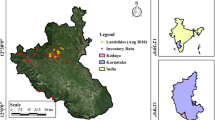Abstract
Synthetic Aperture Radar Differential Interferometry (DInSAR) technique is an effective tool with large coverage and high spatial accuracy for subsidence monitoring. Nevertheless, the temporal resolution is usually poor so that rapid deformation cannot be measured due to the long revisit time of radar satellites. Bistatic SAR Differential Interferometry technique using Global Navigation Satellite System (GNSS) as illuminator has a shorter revisit time, whereas the measurement accuracy is constrained by low signal power, narrow bandwidth and atmospheric delay error. To cope with these problems, in this paper, we propose a novel subsidence monitoring technique based on Space-Surface bistatic Differential Interferometry (SS-DI) with GNSS transmitters, where two stations consist of a reference one and a measurement one that are deployed on the ground. First, we applied a space differential processing between two stations to cancel identical errors such as tropospheric and ionospheric errors etc. Then we used a long time coherent integration to improve the signal noise ratio. Subsequently, we also utilized a time differential processing to construct double differential equations with respect to unknown deformation variables. Finally, we solved the equations to obtain a highly accurate estimation of three dimension deformation. Furthermore, an SS-DI experiment using Beidou-2 as transmitters was carried out to validate the proposed method, where a high accuracy (0.01 mm) device was utilized to simulate subsidence deformation. The experimental results reveal that the proposed method has better performance of spatial measurement accuracy of 0.53 mm compared with differential GPS method.
Similar content being viewed by others
References
Shimada M. Ortho-rectification and slope correction of SAR data using DEM and its accuracy evaluation. IEEE J Sel Top Appl Earth Observations Remote Sens, 2010, 3: 657–671
Hu C, Liu Z, Long T. An improved CS algorithm based on the curved trajectory in geosynchronous SAR. IEEE J Sel Top Appl Earth Observations Remote Sens, 2012, 5: 795–808
He X, Cherniakov M, Zeng T. Signal detectability in SS-BSAR with GNSS non-cooperative transmitter. IEE Proc- Radar Sonar Navig, 2005, 152: 124–132
Zeng T, Cherniakov M, Long T. Generalized approach to resolution analysis in BSAR. IEEE Trans Aerosp Electron Syst, 2005, 41: 461–474
Cherniakov M, Zeng T, Plakidis E. Ambiguity function for bistatic SAR and its application in SS-BSAR performance analysis. In: Proceedings of the 2003 International Radar Conference, Huntsville, 2003. 343–348
Saini R, Zuo R, Cherniakov M. Problem of signal synchronisation in space-surface bistatic synthetic aperture radar based on global navigation satellite emissions-experimental results. IET Radar Sonar Navig, 2010, 4: 110–125
Zeng T, Liu F, Hu C, et al. Image formation algorithm for asymmetric bistatic SAR systems with a fixed receiver. IEEE Trans Geosci Remote Sens, 2012, 50: 4684–4698
Xia Y, Kaufmann H. High resolution D-INSAR measurement for land subsidence. In: Proceedings of 2010 IEEE International Geoscience and Remote Sensing Symposium (IGARSS), Honolulu, 2010. 1541–1544
Hung W C, Hwang C, Chang C P, et al. Monitoring severe aquifer-system compaction and land subsidence in Taiwan using multiple sensors: Yunlin, the southern Choushui River Alluvial Fan. Environ Earth Sci, 2010, 59: 1535–1548
Fujii N, Kobayashi S, Sakurai-Amano T, et al. Crustal movement imaging by D-InSAR, reflector array, dense GPS, leveling and gravity changes in the plate convergent zone, at the Tokai region, central Japan. In: Proceedings of 1999IEEE International Geoscience and Remote Sensing Symposium (IGARSS), Hamburg, 1999. 797–799
Liu F, Antoniou M, Zeng Z, et al. Coherent change detection using passive GNSS-based BSAR: experimental proof of concept. IEEE Trans Geosci Remote Sens, 2013, 51: 4544–4555
Wei H. Performance analysis of GPS carrier phase observable. IEEE Trans Aerosp Electron Syst, 1996, 32: 754–767
Author information
Authors and Affiliations
Corresponding author
Rights and permissions
About this article
Cite this article
Zeng, T., Zhang, T., Tian, W. et al. A novel subsidence monitoring technique based on space-surface bistatic differential interferometry using GNSS as transmitters. Sci. China Inf. Sci. 58, 1–16 (2015). https://doi.org/10.1007/s11432-015-5336-4
Received:
Accepted:
Published:
Issue Date:
DOI: https://doi.org/10.1007/s11432-015-5336-4
Keywords
- differential interferometry
- subsidence monitoring
- Beidou-2/Compass-2
- space-surface bistatic radar
- differential GPS




